How We Certify the Quality of Our Cabinets
Our Step-by-Step Process to Ensure the Quality of Our Cabinets
Without a doubt, kitchen cabinets are one of the most used parts of your home outside of your doors and bed. Whether you’re sliding one open for a fork or knife, opening one to pick up or put away dishes, or doing the back and forth that comes with getting cooking or baking ingredients, you are probably using your cabinets way more than you might think.
We are keenly aware of just how vital these kitchen-based stations are to your life, and for that reason, we ensure that you are only getting the best available for your home.
Of course, any company can say that, and talk is cheap. Thankfully, you don’t have to just believe us without any assurances or proof to back up our claims. Every one of our cabinets goes through rigorous KCMA testing. As such, we only produce and sell KCMA certified cabinets for you and your family.
Wha t is the KCMA Certification?
t is the KCMA Certification?
For those that are unaware of the KCMA and why their certification is so important, they are the Kitchen Cabinet Manufacturers Association and are highly regarded as one of the most stringent and strict associations when it comes to gauging the quality of cabinetry.
Cabinets that receive KCMA certification are recognized by the American National Standards Institute (ANSI) and have been proven to withstand years of household use without falling apart or breaking down.
Our Step-by-Step Verification Process
In order to qualify our cabinets for the KCMA certification, we ensure that each and every cabinet is up to standard. This is made up of five separate categories ranging from cabinet strength and structural integrity, cabinet drawer integrity, cabinet swing and hinge integrity, cabinet exposure resistance; and cabinet heat resistance.
If the cabinet in question fails even one of these five tests (even slightly), it is disqualified from the certification and essentially scraped and repurposed.
Below, we’ll break down each of these tests fully, so you understand exactly what they entail and why each is so important. Keep in mind that, while they may seem excessive at first glance, every household is different, and each needs to accommodate even the most extreme of scenarios.
Step 1. Cabinet Strength & Structural Integrity
First, we test how strong the cabinets hold when under continual weight and pressure. Over the course of an entire week, we load our cabinets with 15 pounds of weight per square foot. From there, we monitor for any signs of the cabinet breaking down or weakening due to structural integrity issues. This can range from slightly joint separation to shelves bending inward.
Our other strength and weight tests include progressively adding over 600 pounds of weight on mounted cabinets. This is meant to simulate the stress that would come from a cabinet space that is heavily loaded. And while we do this for seated cabinets as well, this is particularly stressed and scrutinized for the mounted cabinets due to the increased potential risk of danger.
We also simulate the damaging effects of dropped cans by way of dropping a steel ball (around three pounds) onto the cabinet bottoms.
Step 2. Drawer Integrity and the “Slide Test”
After passing the strength test, our cabinets are then put through the “Slide Test.” This is where their cabinet drawers are slid open and shut over 25,000 times while holding 15 pounds per square foot.
If the cabinet drawers are able to hold without coming loose, breaking at the hinges, or dealing with a broken handle -even after all of that- you know you’re dealing with a quality product.
We also offer our 3 Section Ball Bearing Sliders, which take this to the next level, effectively able to handle considerably more “wear and tear” compared to the standard option.
Step 3. The Swing Test
Once they have passed the Slide Test, our cabinets are then put through a Swing Test. Here, we ensure the quality of the cabinet’s hinges and that they are at the highest standard available.
The Swing Test works by testing both the cabinet door itself as well as the hinges. We put the door through over 25,000 swing cycles while having it withstand over 65 pounds of weight. If, after the full test, the door has no signs of damage or looseness while also still working perfectly, then the cabinet passes.
For our concealed and soft-close hinges, this is even further tested. Because the soft-close option has a hydraulic dampening effect, ensuring that they work perfectly is even more important.
Step 4. Cabinet Resistance to Liquid Exposure
Also known as the “Spill Test,” we understand that real life isn’t pristine, and it isn’t perfect. Accidents happen, and spills can occur. In order to account for these accidents, we keep it as a goal that our cabinets can resist the negative effects that may come from being exposed to liquids as well as abrasive substances.
Our cabinets are exposed to different “spills” like coffee, alcohol, mustard, grape juice, and vinegar. There, it is allowed to “sit” for a set amount of time before being cleaned off. For most of the liquids, it is left on for around 24 hours. Mustard is the one exception to the rule, sitting on your cabinet for only an hour. If the cabinet showed no sign of exposure, we know it’s a keeper.
Step 5. Heat Exposure
Finally, we put our cabinets in a hotbox for an entire 24-hour day cycle. The hotbox is kept at a high 120-degree temperature and is intentionally very humid as well as hot. This means there is additional stress that comes from the air moisture. This is on top of the potential damage caused due to the heat.
Cabinets that can hold their appearance even despite the high temperatures can handle almost anything the average family would put it through.
Conclusion
Our cabinets are only able to keep their quality rating and be presented as options for the KCMA certification after completing and passing all of the five tests. By having this as proof of quality, you can understand and know that our cabinets are the real deal and the top of the line.
You can go for a cabinet that hasn’t been certified by the KCMA. And while that may work out for you, the fact of the matter is that it just isn’t going to be at the same level of quality that is offered here. Expect something that falls apart faster, breaks down easier, and is more likely to warp in the heat and stain from spills.
We offer cabinets that are of the highest standard and, now that you see what we do to verify that, you can feel confident that you are getting the best the industry has to offer.


 t is the KCMA Certification?
t is the KCMA Certification?